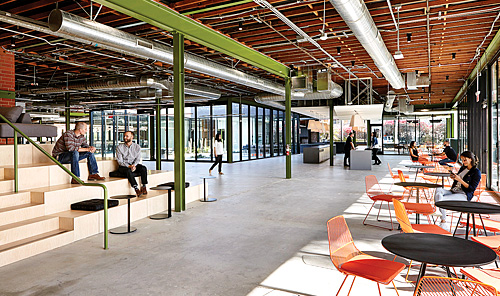In Focus: The Evolving Role of Outdoor Spaces
Outdoor collaboration zones can provide workers with a sense of safety and return to “normal” in a post-COVID-19 world.
Q4 2020

On a macro-level, spaces must be reimagined in order for people to return safely and once again participate in day-to-day activities without fear of getting sick or infecting others. One solution is moving traditionally indoor spaces outdoors. The office is a great example of how outdoor solutions can help to bring people back to a sense of normalcy.
Nature’s Influence on Our Wellbeing
It is well known that nature can have a positive impact on a human’s well-being. Simple solutions like plants and windows that look onto natural environments have been shown to boost attitudes and make people feel calmer. Prior to the pandemic, people had more engagement with nature and the outdoors, whether that was walking through a farmers’ market to get to the office or going to a nearby park for lunch. Oftentimes these outdoor spaces were also associated with social gathering and interaction with others. Without these daily activities, working from home can increase the feelings of isolation and separation.
The office is a great example of how outdoor solutions can help to bring people back to a sense of normalcy. This is an opportunity for facility managers to look at their buildings and reimagine their available space to create outdoor escapes people will want to go to. By providing a rooftop or patio for building occupants to use, workers will be excited to go back to the office to use spaces they might not have access to in their own home.
Creating the Outdoor Office
Office space has often been shaped from the inside out, but perhaps now is the time to think outside in. Buildings have become sealed, containing environments –– many of which do not even have operable windows. As the demand for sanitization increases, there has become a greater emphasis on fresh air rather than purified air. Outdoor collaboration zones offer that benefit.
Office space has often been shaped from the inside out, but perhaps now is the time to think outside in. These zones can be structured in a few different ways depending on the needs of the workers. A workspace can be a series of pavilions (fully built out or partially enclosed) within a larger outdoor environment with interstitial spaces in between for individual work. These can include greenhouse type spaces that are more enclosed, with flexible furniture solutions to adapt to different interactions. Now is the time to push the boundaries of what we think an office space can be. If we provide the same diversity in seating and working setups in our outdoor spaces as we do for our indoor spaces, it can only benefit the user.
As we navigate this “new normal” and bring our work outdoors, one of the challenges of open-air space actually may be its greatest strength. With the need for people to be constantly connected to their devices, creating an outdoor space that supports technology can sometimes prove to be difficult, given that it requires certain IT and weather-proof infrastructure that may not already be present in the area. However, with all the talk about Zoom fatigue and the desire for human connection, a question is raised about whether or not these optimized, outdoor spaces could or should remain tech-free. If what we’re craving is a venue for safe, human-to-human collaboration, a quiet spot outside may be better suited as a moment of relief and disconnect than simply another location to video chat after all.
Project Announcements
Australia-Based Aquatic Leisure Technologies Group Plans Opp, Alabama, Manufacturing Operations
12/11/2025
Teradyne Plans Wixom, Michigan, Robotics Operations
12/11/2025
Robinson Plans Altoona, Iowa, Manufacturing Operations
12/11/2025
BioTouch Expands Columbus, Georgia, Operations
12/11/2025
Natrion Plans Erie County, New York, Battery Components Operations
12/11/2025
Czech-Based GZ PrintPak Expands Mount Pleasant, Wisconsin, Manufacturing Operations
12/11/2025
Most Read
-
The Workforce Bottleneck in America’s Manufacturing Revival
Q4 2025
-
Rethinking Local Governments Through Consolidation and Choice
Q3 2025
-
First Person: Filter King’s Expansion Playbook
Q3 2025
-
Lead with Facts, Land the Deal
Q3 2025
-
How Canada Stays Competitive
Q3 2025
-
Investors Seek Shelter in Food-Focused Real Estate
Q3 2025
-
America’s Aerospace Reboot
Q3 2025